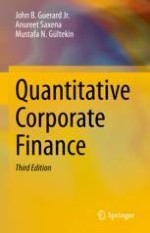2022 | OriginalPaper | Buchkapitel
13. Time Series Modeling and the Forecasting Effectiveness of the US Leading Economic Indicators
verfasst von : John B. Guerard Jr., Anureet Saxena, Mustafa N. Gültekin
Erschienen in: Quantitative Corporate Finance
Aktivieren Sie unsere intelligente Suche, um passende Fachinhalte oder Patente zu finden.
Wählen Sie Textabschnitte aus um mit Künstlicher Intelligenz passenden Patente zu finden. powered by
Markieren Sie Textabschnitte, um KI-gestützt weitere passende Inhalte zu finden. powered by
